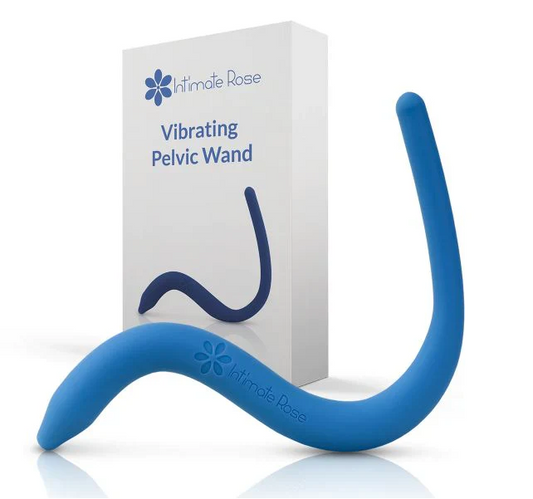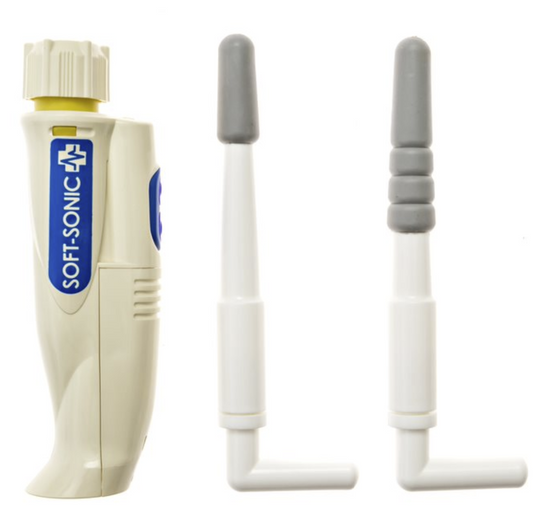
The Ultimate Guide to Pelvic Floor Massage: Techniques, Benefits, and When to See a Pro
Share
Living with ongoing pelvic pain can be frustrating, especially when it feels too uncomfortable to talk about. Agency for Healthcare Research and Quality (AHRQ) notes that chronic pelvic pain syndrome (CPPS) in men has a worldwide prevalence between 2 % and 16 %. The impact on quality of life is comparable to serious conditions like myocardial infarction or diabetes
The good news is that pelvic floor massage offers a natural, effective way to ease this discomfort at home. This hands-on method has helped many people feel better and more confident in their daily lives.
In this article, you’ll find a simple, step-by-step guide to pelvic floor massage. You'll learn how it works, how to do it safely, and when it's time to seek help from a professional.
What is Pelvic Floor Massage?
Pelvic floor massage is a therapeutic technique that helps relax tight muscles and release trigger points around your pelvic organs. It’s a focused way to care for muscles that are often overlooked but play a big role in daily comfort and function.
These muscles can become tense or weak due to stress, childbirth, injury, poor posture, or sitting for long periods. When they stay tight, they can cause pain, discomfort, or problems with bladder and bowel function.
Pelvic floor massage helps by using gentle pressure to ease knots and improve how the muscles work.
This can be done in two ways, external massage, which targets the perineum and nearby areas, and internal massage, which works deeper inside. Both can be helpful, depending on your needs.
What are the Benefits of Pelvic Floor Massage?
Pelvic floor massage offers both physical and emotional relief by targeting muscle tension, improving circulation, and supporting overall pelvic health.
Alleviates Chronic Pelvic Pain
One of the most notable benefits of pelvic floor massage is pain relief. By targeting muscle spasms and breaking down trigger points, the massage helps ease the chronic discomfort often linked to pelvic tension.
While some people experience noticeable improvement after just a few sessions, regular and consistent treatment is essential for long-term results.
Improves Sexual Function
For individuals experiencing pain during intimacy, pelvic floor massage can offer transformative relief. By easing muscle tension and boosting blood flow, it often reduces dyspareunia (painful intercourse) while enhancing overall sensation.
As a result, this improvement not only promotes physical comfort but also supports emotional connection and well-being within relationships.
Moreover, a comprehensive narrative review spanning 37 studies underscored that pelvic floor physical therapy, when paired with manual techniques and individualized training, can effectively improve both erectile dysfunction and premature ejaculation in men.
Supports Postpartum Recovery
New mothers often find pelvic floor massage especially helpful. Pregnancy and childbirth put a lot of strain on these muscles, which can lead to pain or tightness.
Massage helps the muscles heal and work properly again. It’s also useful for softening scar tissue from episiotomies or tears, while providing relief from tension and discomfort.
Enhances Bladder & Bowel Control
A relaxed and healthy pelvic floor is important for good bladder and bowel control. When the muscles are too tight, they have trouble responding to signals from the brain.
This can lead to problems like incontinence or constipation. Regular massage helps rebuild that mind-body connection, improving muscle control and easing these issues.
Reduces Stress and Anxiety
Beyond its physical benefits, pelvic floor massage also supports emotional and mental well-being by strengthening the mind-body connection.
The relaxation techniques used during massage can help lower overall stress levels and promote a sense of calm. For many, the experience feels meditative, offering both physical relief and emotional balance.
A Step-by-Step Guide to Pelvic Floor Massage at Home
With the right preparation and technique, you can safely perform pelvic floor massage at home to help relieve tension and improve comfort.
Pre-Massage Preparation
Step 1: Create a calm, private environment where you won't be interrupted.
Step 2: Gather your supplies including high-quality lubricant and a pelvic wand if you plan to use one. Having everything within reach prevents disruption during the massage. Make sure your hands and tools are clean.
Step 4: Take several deep breaths and allow yourself to mentally relax. This preparation helps your body respond better to the massage techniques.
External Massage Techniques
Begin with external massage to help you get comfortable with the area and ease into the relaxation process.
Step 1: Wash your hands and apply a small amount of lubricant to your fingers. Get into a comfortable position, either lying down or sitting.
Step 2: Start with gentle, circular motions on the perineum (the area between the vagina and anus) using light pressure to warm up the tissues.
Step 3: Slowly increase pressure as the area relaxes. Focus on any spots that feel tight or sore, spending a little more time there.
Step 4: Continue massaging for 5–10 minutes, paying attention to how your body feels and adjusting as needed.
Internal Massage Techniques
Internal massage requires greater care and attention, so it’s important to move slowly and pause if anything feels uncomfortable.
Step 1: Apply plenty of lubricant to your finger or pelvic wand. Take your time and make sure you’re comfortable.
Step 2: Gently insert your finger or tool, letting your muscles relax. Stop if anything feels painful.
Step 3: Use the "clock" method by imagining your pelvic opening as a clock face. Start at the 6 o'clock position and work your way around systematically.
Step 4: Press gently on each spot, focusing more on areas that feel tight or sore. It should feel like relief, not pain
Using a Pelvic Wand
A pelvic wand allows for a deeper, more targeted massage than using fingers. Its shape gives better control and helps reach hard-to-access muscles.
Step 1: Apply plenty of lubricant to both the wand and the vaginal opening. This helps with comfort and easier insertion.
Step 2: Gently insert the curved end of the wand, allowing your muscles to relax. Take your time and pause if needed.
Step 3: Use the curved end to apply light pressure along the pelvic floor, moving around the “clock” positions as you go.
Step 4: Keep steady pressure without straining. The wand’s design helps you reach deeper muscles and makes longer sessions easier.
Pelvic Floor Massage vs. Other Treatments
To choose the right approach for your needs, it helps to compare how different treatments work and what they’re best suited for.
|
Treatment |
Purpose |
Best For |
|
Pelvic Floor Massage |
Releases tension and trigger points |
Muscle tightness, pain relief |
|
Kegel Exercises |
Strengthens weak muscles |
Incontinence, post-pregnancy |
|
Physical Therapy |
Comprehensive assessment and treatment |
Complex conditions, professional guidance |
Understanding the difference between these techniques can guide you toward better care. While Kegels help strengthen pelvic floor muscles, massage focuses on relaxing them. Often, a combination of both is the most effective approach.
Still, it’s important to remember that at-home massage is just a supplement, not a replacement, for professional treatment. If your symptoms are complex or haven’t improved with self-care, seeing a trained pelvic floor therapist can provide the expert support you need.
When to Avoid Pelvic Floor Massage (And When to See a Doctor)
Pelvic floor massage can be helpful, but it’s not always the right choice. In some situations, doing it on your own may cause more harm than good. That’s why it’s important to know when to stop and talk to a doctor.
The following situations call for extra caution or a medical evaluation:
- Active pelvic or vaginal infections
- Recent pelvic surgery or childbirth (within 6-8 weeks)
- Severe, unexplained pelvic pain
- Heavy bleeding or unusual discharge
- Pregnancy complications or high-risk pregnancy
Stop immediately if you experience increased pain, bleeding, or any concerning symptoms during or after massage. Your safety always comes first, and these warning signs warrant immediate medical attention.
FAQs
Is pelvic floor massage painful?
Properly performed massage should feel therapeutic, not painful. You might experience some discomfort when working on tight areas, but sharp or severe pain indicates you should stop and potentially consult a professional.
How often should I do a pelvic floor massage?
Generally speaking, 2-3 times per week is a good starting point for most people. Consistency matters more than frequency, so find a schedule you can maintain long-term.
Can men benefit from pelvic floor massage?
Absolutely. Men experience pelvic floor dysfunction too, particularly related to prostate issues, chronic pain, and post-surgical recovery. The techniques are similar, though the anatomy requires slight modifications.
What kind of lubricant should I use when doing a pelvic floor massage?
Choose a high-quality, body-safe lubricant without glycerin or parabens. Water-based options work well for most people, while silicone-based lubricants last longer but shouldn't be used with silicone tools.
What's the difference between a pelvic wand and a dilator?
Pelvic wands are designed specifically for massage and trigger point release with curved shapes for better leverage. Dilators focus on gentle stretching and are typically straight with graduated sizes.
Transform Your Pelvic Health with the Prostate Health Store Advantage
Your journey to a healthier, more comfortable life begins with understanding and caring for your pelvic floor. By incorporating the principles of pelvic floor massage, you can actively work towards reducing pain, improving function, and regaining control.
To support your self-care routine, a pelvic wand can be an invaluable tool for reaching deep, hard-to-access trigger points.
Prostate Health Store's Pelvic Floor Wand is meticulously designed with a unique ergonomic shape and smooth, medical-grade silicone to make this process easier and more effective.
Ready to take control of your pelvic wellness? Explore the Prostate Health Store's Pelvic Floor Wand and begin your journey to relief today.




